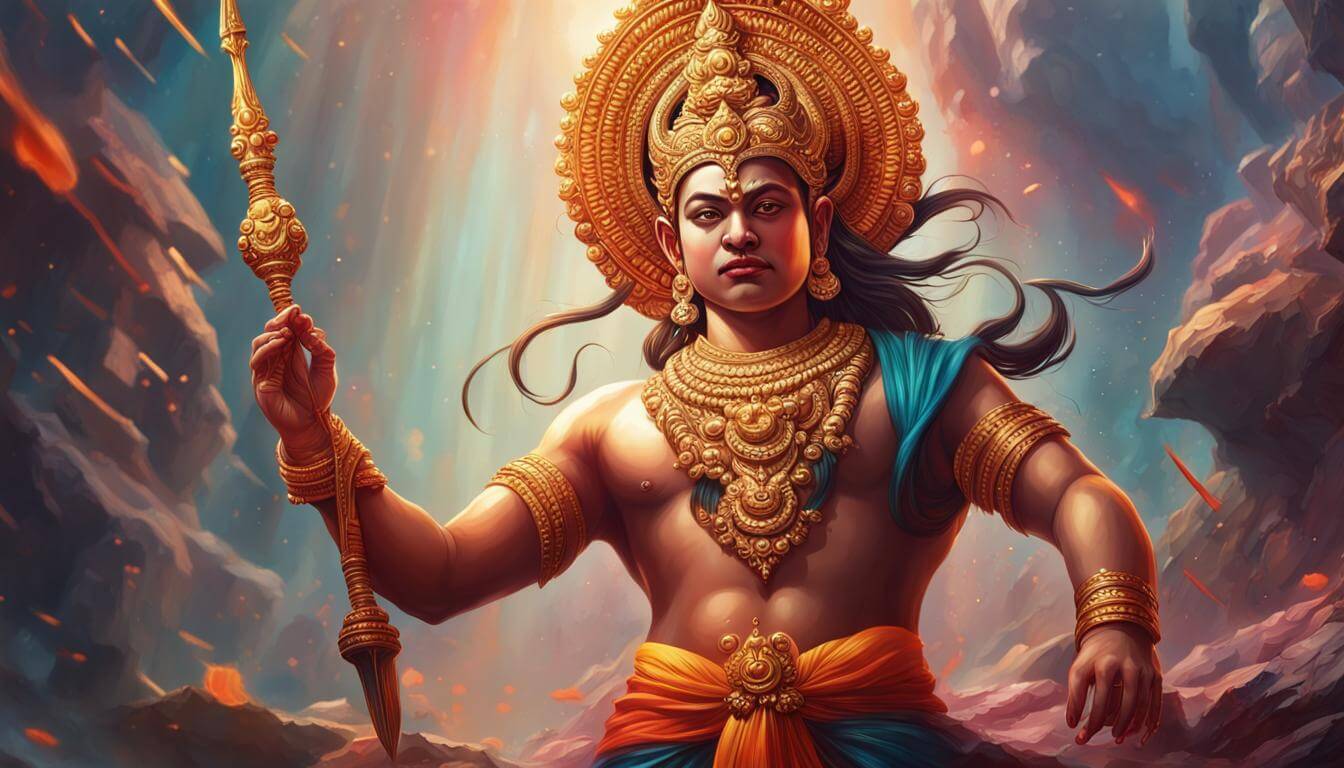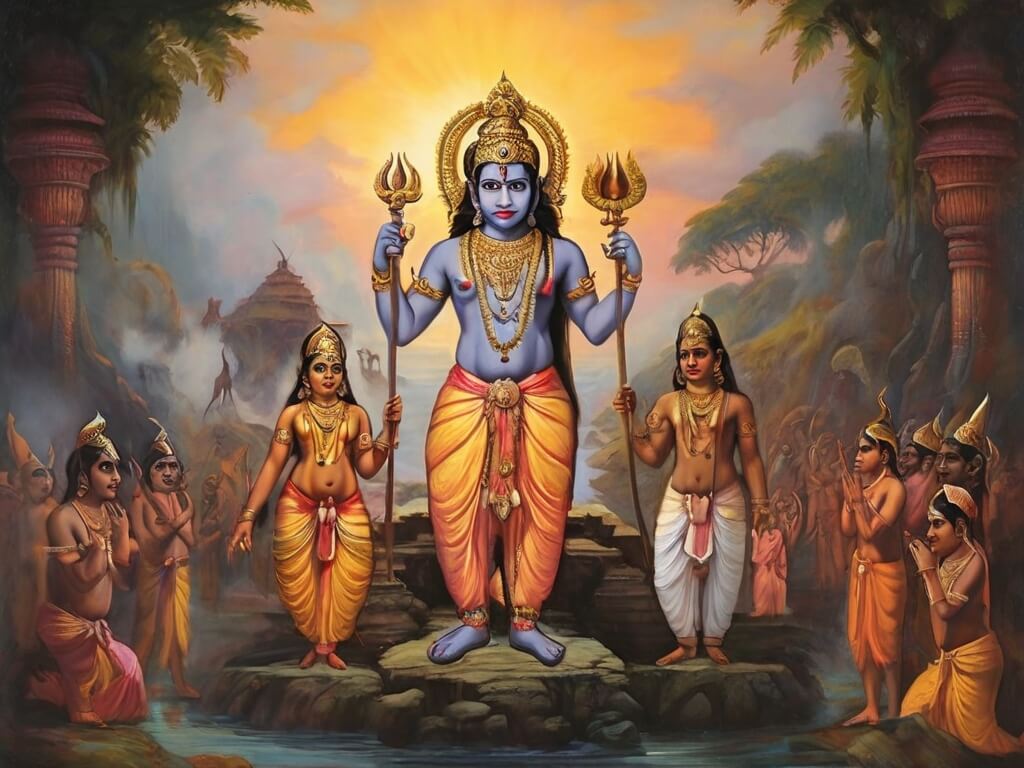Explore the profound narrative of the Ramayana, a revered Sanskrit epic attributed to the sage Valmiki. With 24,000 couplets divided into seven sections, the epic unfolds the life and adventures of Lord Rama, showcasing values like righteousness, devotion, and duty. Immerse yourself in the rich tapestry of characters, from Rama and Sita to Hanuman, as the epic weaves a tapestry of moral guidance and spiritual inspiration.

Ramayana; one of the two great Sanskrit epics of India (the other being the Mahabharata) contains 24,000 couplets and is divided into seven sections. There are three recensions : the West Indian, the Bengal, and the Bombay. According to A. A. Macdonell, the major portion of the work was composed about 500 b.c. It is the first kavya (artificial epic) produced in India and abounds in rich similes, fantastic anecdotes, and other ornamentation familiar in classical poets. Valmiki, the author, had been a highwayman in early life but became a saint through repeating Rama’s name. It is said that, moved at the death of a male dove killed by a hunter’s arrow while sporting with its mate, Valmiki uttered an exclamation, whereupon a voice from heaven declared that he had unwittingly created the sloka meter and bade him write in that meter of the life and deeds of Rama. The Ramayana was sung by bards at religious ceremonies. It is not an allegory but is based on various legends about Rama current at the time of its writing.
The influence of the Ramayana on Indian culture is incalculable. Rama and Sita are widely worshiped as divine personifications. Sita’s conjugal devotion, Rama’s magnanimity and sense of duty, Lakshmana’s fidelity to Rama, and Hanuman’s devoted service greatly appeal to the Hindu mind. The work has been translated into many of the Indian vernaculars. Sanskrit dramatists and poets—such as Kalidasa, Bhatti, and Bhavabhuti—have selected their themes from the Ramayana, which also inspired the medieval saint Tulsidas to write the Rama-charita-manasa, read with devotion by millions of Hindus even in the 20th century.
RAMA
RAMA, sixth incarnation of Vishnu, whose life is narrated in the Ramayana. Rama was the eldest son of Dasaratha, king of Ayodhya, in northern India. As old age approached, the king wished to install Rama as heir apparent, but was frustrated by his wily second wife, who, recalling a past promise of the king, succeeded in making her own son heir apparent and exiling Rama for fourteen years. With his wife Sita and brother Lakshmana, Rama went to the forest, where he protected the ascetics and their religious observances. His deeds enraged Ravana, the monster king of Ceylon, who came in disguise and carried off Sita. With the help of the monkey chief Sugriva and Hanuman, Rama invaded Ceylon and killed Ravana. A happy reunion followed. Returning to the ancestral capital, Rama was crowned king amid the jubilation of his subjects. His rule ushered in a golden age characterized by universal spiritual and material welfare. Because of a rumor impugning Sita’s character, on account of her long residence in Ravana’s palace, the dutiful king reluctantly sent her to the forest hermitage of Valmiki, where she gave birth to twin sons, Lava and Kusa, to whom the sage later taught the Ramayana. The family was ultimately reunited.

Story of Ramayana
The Ramayana is one of the most significant and revered epics in Hindu mythology, narrating the life and adventures of Lord Rama. The epic is traditionally attributed to the sage Valmiki and is composed in Sanskrit. The story is divided into seven books or Kandas, each depicting different phases of Rama’s life.
1. Balakanda (The Book of Youth): The Ramayana begins with the birth of Prince Rama, the seventh avatar of Lord Vishnu, to King Dasharatha of Ayodhya and his three queens, Kausalya, Kaikeyi, and Sumitra. Rama’s childhood, marriage to Sita (an avatar of Goddess Lakshmi), and his exile to the forest at the request of Kaikeyi are covered in this book.
2. Ayodhyakanda (The Book of Ayodhya): King Dasharatha’s grief at Rama’s exile and his subsequent death are depicted in this section. Bharata, Rama’s half-brother and son of Kaikeyi, returns to Ayodhya to find it in chaos. He learns about Rama’s exile and refuses to accept the throne, instead, opting to bring Rama back.
3. Aranyakanda (The Book of the Forest): This book narrates Rama, Sita, and Lakshmana’s life in the Dandaka forest during their fourteen-year exile. It introduces several key characters like Surpanakha, a demoness, and Shurpanakha’s encounter with Rama and Lakshmana, leading to the famous “cutting off of Surpanakha’s nose.”
4. Kishkindhakanda (The Book of Kishkindha): This section tells the story of Rama’s alliance with Hanuman and the search for Sita, who has been abducted by the demon king Ravana. Hanuman discovers Sita in Lanka and conveys her plight to Rama. The friendship between Rama and Sugriva, the vanara king, is also depicted in this book.
5. Sundarakanda (The Book of Beauty): Hanuman’s journey to Lanka, his encounter with Sita, the burning of Lanka’s city by Hanuman’s fiery tail, and the subsequent events are covered in this section. Hanuman’s devotion to Rama and his heroic deeds play a crucial role in the narrative.
6. Yuddhakanda (The Book of War): This is the climax of the Ramayana, where the great war between Rama’s army of monkeys and Ravana’s demon forces takes place. The epic battle includes the famous episodes of Rama’s construction of the bridge to Lanka (Rama Setu) and the killing of Ravana by Rama.
7. Uttarakanda (The Book of the Aftermath): This final book covers the return of Rama and Sita to Ayodhya, the agnipariksha (fire ordeal) faced by Sita, and Rama’s subsequent banishment of a pregnant Sita to the forest. The birth of Rama’s sons, Lava and Kusha, and their reunion with their father, along with Rama’s decision to return to his celestial abode, are also detailed in this book.
The Ramayana serves as a moral and spiritual guide, teaching values such as dharma (righteousness), devotion, and the importance of fulfilling one’s duties. It continues to be a source of inspiration for millions of people, not just in India but around the world.